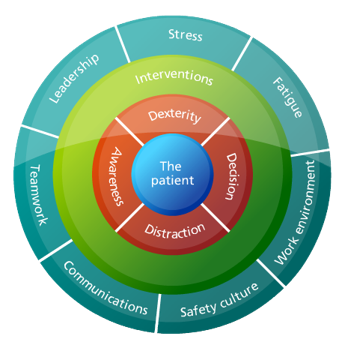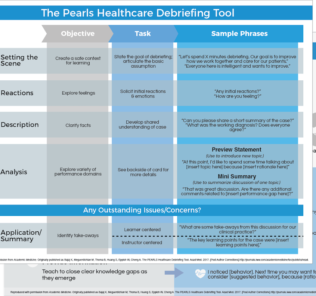Clinical Simulation: A Key Strategy for Improving Patient Safety
The role of healthcare simulation in improving patient safety expands every year however, persuading hospital and clinic administrators to increase funding for simulation may be challenging. Today’s article was guest author Dr. Kim Baily PhD, MSN, RN, CNE, previous Simulation Coordinator for Los Angeles Harbor College and Director of Nursing for El Camino College reviews an excellent research article by Paige, Fairbanks and Gaba (2018) entitled Priorities Related to Improving Healthcare Safety Through Simulation. Although the article focuses on medical simulation research design for improving patient safety, it provides detailed information about the many benefits of clinical simulation.
Those seeking funding for clinically based simulation programs, will find helpful discussions about the role of simulation in promoting high reliability organizations, creating change in institutional culture, building resilience and preventing adverse events.
The gap between the desired outcome of zero patient harm and the reality of over 250,000 deaths per annum from medical errors is related to many factors including the extensive variation in the tasks and products involved in healthcare and the diversity of the motivations and characteristics of the healthcare team (human factors).
Sponsored Content:
Benefits of Simulation in Healthcare
Simulation in Healthcare helps create High Reliability Organizations (HRO): HRO are organizations that have the potential for catastrophic failure yet engage in nearly error-free performance. The healthcare industry differs considerably from HROs such as the airline industry because of the variation in healthcare settings, the focus in healthcare on patients rather than machines and the fact that failures occur to individuals rather than mass casualties. Extensive investigation and publicity follow major airline crashes whereas individual adverse patient events do not receive the same attention.
Simulation Helps to Create an HRO
Creating a Safety Culture. Simulation can help create a proactive environment which is blame-free. Simulation training may be offered to individuals, teams and larger units and scenarios can be created that match clinical situations that providers find the most worrisome. Simulation can be used to identify situations that have a potential to cause harm before they occur in actual practice. Educators know that simulation can produce moments of clarity for learners that will change their future practice for the better.
Sponsored Content:
Simulation can be used to test and improve processes and procedures. Use of standardization operating procedures (SOPs) based on evidence-based practice throughout an institution prevents variability and reduces error. In addition, nursing simulation promotes flexible responses where every member of a team is empowered to speak up if they have a concern.
Simulation Provides Opportunities for Extensive Training Which Can Be Configured By:
Building and Maintaining Resilience: Organizations should identify possible threats to patient safety and actual errors as soon as possible and then alleviate and correct them. Responding quickly requires adaptability at both the individual and system level. Simulation activities can help build resilience e.g. online scenario training, high/low fidelity simulations with debriefing and virtual reality exercises. In 2014 during the US Ebola outbreak, several centers in the US were tasked with treating Ebola patients. Simulation activities both in preparation for an outbreak and during the actual outbreak helped these organizations respond quickly to the threat of treating patients with highly virulent body fluids.
Evaluating the Impact of Adverse Events: Human Factors Engineering is the science dealing with the application of information on physical and psychological characteristics to the design of devices and systems for human use. There are three framework levels for patient safety. At the primary level of prevention of adverse events, simulation is used to develop system components in ways that maximize safety prior to the installation of a system. At the secondary level prevention, simulation may also be used to establish where existing risks and hazards already exist. Finally at the tertiary level, clinical simulation is used to help to determine the cause of an adverse event that has already occurred.
Simulation plays a critical role in the identification of the causal nature of medical errors and in the prevention of future errors. Although the cost of simulation equipment and remuneration for staff and faculty may be high, in the long term simulation will play a vital part in improving patient safety.
Further Reading: Priorities Related to Improving Healthcare Safety Through Simulation
Abstract: Improving healthcare safety is a worthwhile and important endeavor. Simulation-based activities can help with such a goal through research and training. In this manner, it can focus on education and training, assessment and metrics, process improvement, and culture change to help move forward both patient safety and quality of care.This article will address the following three main topics: (1) designing simulation-based activities to promote high reliability in healthcare, (2) developing simulation-based activities to foster resilience in healthcare systems, and (3) evaluating the impact of adverse events in healthcare and how simulation-based activities can be used to determine and potentially to prevent their cause. These topics will be treated sequentially, providing synopses of concepts and giving examples of research currently being undertaken. It will then highlight current priorities for simulation-based research in this domain by drawing from insights obtained and a targeted literature review.
Further Engagement: Patient Safety Movement Foundation’s Upcoming MidYear Planning Event
Looking to learn more about Patient Safety? The Patient Safety Movement Foundation’s Midyear Planning Meeting, co-convened with UC Irvine Health, will take place on Tuesday, September 17th, 2019, at the Beckman Center of the National Academies of Sciences & Engineering, University of California, Irvine (UCI) on World Patient Safety Day! This full-day working meeting will bring together one hundred global stakeholders across healthcare for an intimate examination and discussion about how we can continue planning for ZERO preventable deaths in hospitals. This meeting allows an opportunity for participants to provide their experiences and expertise as we propel our mission of ZERO forward. We hope to see you there! Who Should Attend | We are all-inclusive. We invite administrators, clinicians, representatives of professional bodies, non-profits focused on patient safety, patients and family members, engineers, and all other patient safety enthusiasts to the table. Learn more here!
Subscribe for More Great Patient Safety in Healthcare Simulation Content!
Today’s article was guest authored Dr. Kim Baily PhD, MSN, RN, CNE, previous Simulation Coordinator for Los Angeles Harbor College and Director of Nursing for El Camino College. Over the past 16 years Kim has developed and implemented several college simulation programs and previously chaired the Southern California Simulation Collaborative.
Have a story to share with the global healthcare simulation community? Submit your simulation news and resources here!
Dr. Kim Baily, MSN, PhD, RN, CNE has had a passion for healthcare simulation since she pulled her first sim man out of the closet and into the light in 2002. She has been a full-time educator and director of nursing and was responsible for building and implementing two nursing simulation programs at El Camino College and Pasadena City College in Southern California. Dr. Baily is a member of both INACSL and SSH. She serves as a consultant for emerging clinical simulation programs and has previously chaired Southern California Simulation Collaborative, which supports healthcare professionals working in healthcare simulation in both hospitals and academic institutions throughout Southern California. Dr. Baily has taught a variety of nursing and medical simulation-related courses in a variety of forums, such as on-site simulation in healthcare debriefing workshops and online courses. Since retiring from full time teaching, she has written over 100 healthcare simulation educational articles for HealthySimulation.com while traveling around the country via her RV out of California.
Sponsored Content:




















